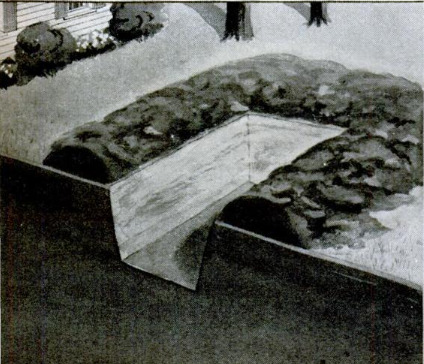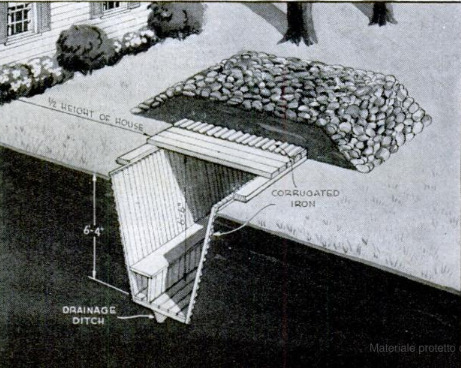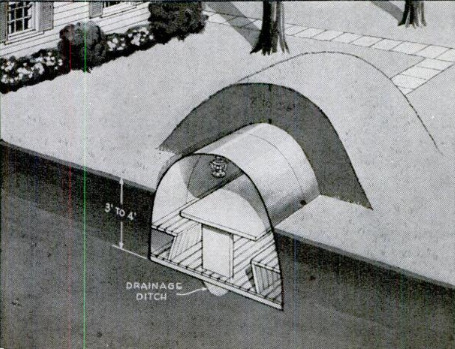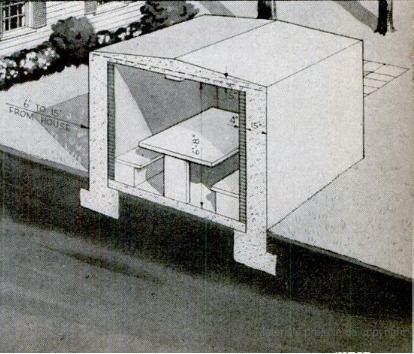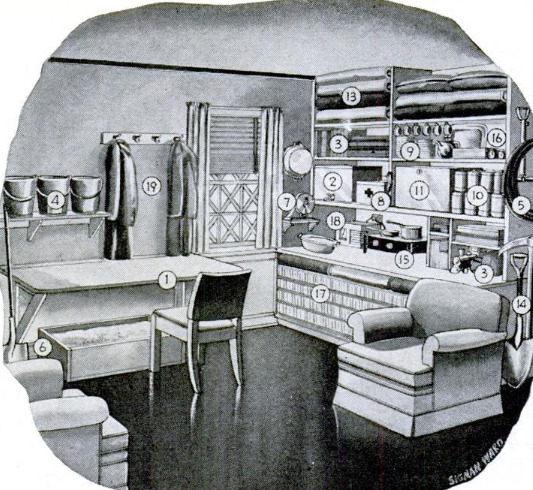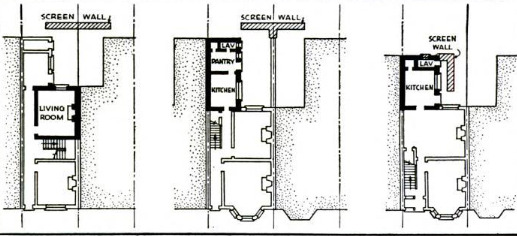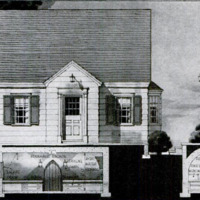-
Titolo
-
How homes can be protected from air attack
-
Article Title and/or Image Caption
-
Title: How homes can be protected from air attack
-
extracted text
-
BY BREAKING DOWN the hours of work
and leisure of the average citizen it has
been estimated that the chances are better
than three out of five that an enemy bombing
attack will take place while he is at home,
Thus, protection of the home and those with-
in it becomes of paramount importance.
There are five general types of shelter
a home owner may use, and his choice will
depend on such considerations as expense,
ease of construction, comfort, and vulner-
ability. These types, shown on the following
pages, are:
1. A refuge room, within his
home.
2. An open trench in his yard.
This is good protection against
blast and splinters from a high-
explosive bomb, but is no protec-
tion against gas or falling splinters
from an antiaircraft shell, and is
a miserable makeshift in inclement
weather.
3. A trench dug at least 6 feet 6
inches in the ground, with side
walls of planks or corrugated iron
and covered with 2 to 21% feet of
earth supported by planking or
corrugated iron. For the sake of
safety from a direct hit on the
home, such a trench should be built
at least half the distance of the height of
the walls away from the house. This trench
is safer than a room in the house, but is apt
to be uncomfortable.
4. A semisurface type of trench, like the
Anderson type in use in England, formed
by placing preformed arched sections of
sheet steel or reénforced concrete in a
trench 3 or 4 feet deep and covering the
sections with earth to a depth of 2 to 21%
feet. These give as much protection as the
covered trench, but are more expensive and
suffer the same disadvantages of discomfort.
5. Shelters that are essentially pill boxes,
built on the surface of the ground of con-
crete or brick. The external walls should
be 13% inches standard brickwork, or 15
inches of sound concrete; the interior walls
should be 4 inches of brickwork and the
roof should be built of 5 inches of reénforced
concrete. They should be placed within 6
to 15 feet from the house in order that the
walls of the house may serve as additional
blast protection. These shelters are com-
fortable, dry, but expensive.
The required standard of overhead pro-
tection against blast and fragments from a
500-pound bomb bursting 50 feet away is
afforded by: 1/4 inch of mild steel plate;
4 inches of reénforced concrete; 6 inches of
ordinary concrete; brickwork or masonry
arches of not less than 8 1/2; inches crown
thickness; or 18 to 24 inches of earth,
sandbags, ballast, or broken stone. If im-
munity against direct hits of the most
frequently used bombs (ie, up to 550-
pounds) is desired, the overhead cover of
the shelter must be increased to a minimum
of 7 feet of reénforced concrete.
Since protection on Lhis scale tor large
numbers of people would involve immense
cost, it is considered impracticable for gen-
eral use, and the first-mentioned standard of
overhead cover is the one most widely used.
The required standard of lateral protection
for outdoor shelters is secured by 1 1/2; inches
of mild steel plates; 13 1/2-inch walls of good
brickwork (ie. 1 1/2 bricks thick), or sound
stone masonry; 12 inches of reénforced con-
crete; or by 30 inches of earth, sandbags,
ballast, or broken stone.
All these types of shelters, it should be
stated parenthetically, are not designed to
offer protection against a direct hit of a
high-explosive bomb, such as the general-
purpose bomb, the kind generally used
against urban areas. The heavier 660-pound
to 4,000-pound demolition bombs usually
are reserved for specific military targets,
and the smaller 22-pound to 55-pound
fragmentation bombs are designed for at-
tack on troops in the field.
Civilians have most to fear from general-
purpose, high-explosive bombs, which range
from 45 to 550 pounds; gas bombs, from
22 to 550 pounds, and gas sprays; and from
incendiary bombs, ranging from 2 1/5
pounds to 55 pounds. The small type, known
as the electron bomb, and consisting of a |
magnesium tube filled with powdered alumi- |
num and iron oxide, called thermite, is con |
sidered the most effective. One large bomb- |
er can carry from 1,000 to 2,000 of these
small incendiaries and scatter them over
a wide area. |
To the average house owner the refuge
room, for reasons of economy and comfort, |
has usually a greater appeal than any other |
type of domestic shelter. But if his house |
is of light wooden construction a refuge |
room will not afford the necessary amount |
of safety for himself and his family and he |
must choose one of the other types of |
shelter. For it requires 13 1/2 inches of |
brickwork to give full protection against |
bomb splinters and 9 inches of brick wall |
to stop the majority of splinters. |
Fortunately this does not mean that a
refuge room must be inclosed in 9 to 13%
inches of brick in order to be comparatively
safe. The thickness of all walls within 30
feet from the refuge room may be con-
sidered as added to the thickness of the
room walls. The house next door, for ex-
ample, if it is within the 30-foot limit, or a
high garden wall, could be considered as
part of the protection of a refuge room.
As a general rule, a refuge room in the
basement is preferable, since it affords the
best protection against blast and fragments.
In stories above the ground level there is
always danger that fragments from high-
explosive bombs falling near a building will
strike upward through a window below the
room and then through the floor of the
room. For this reason, when a refuge room
in the basement is not feasible, a protected
room on the ground floor is usually the best
location for a refuge room. The next-best
location is an inner room upstairs, but not
on the top floor. The guiding principle is
to choose a room that already is protected
as much as possible by surrounding walls
of brick, stone, or concrete, including those
of the house next door.
The most favorable place for a ground-
floor or upstairs refuge room is a corridor
or an inner room without windows, or a
room with a window facing a narrow court
or alley, so as to secure partial protection
from neighboring walls. Windows and doors
of refuge rooms which are mot already
shielded by another house or solid wall
within a distance of 30 feet must be
especially protected against bomb blast and
splinters by blocking them up, or by erect-
ing barricades around them outside the
building. In either case the protection
should be raised to a height of at least 6
feet above the floor of the room so that
occupants will be out of danger of splinters.
The simplest way to block a window or
door that is not needed is to brick it up with
good brick masonry, 1 1/2 bricks (13) thick.
A less expensive method is to build a
frame crate over the outside of the window
and fill it with earth, loose gravel, or
shingle, to a thickness of 24 to 30 inches.
The most effective method of protecting a
window against the blast of high-explosive
bombs is to construct around the outside of
the window sandbag walls or earth traverses
2 feet 6 inches thick, which must entirely
cover the window opening and abut the
brickwork with an overlap of at least one
foot all around.
The protection of windows is extremely
important, for gas may be used by the
enemy concurrently with high-explosive
bombs, and the shattering of the windows
would permit gas to seep into the room.
Where windows cannot be protected by
barricades it is necessary to reénforce or
replace the ordinary glass by some non-
shattering transparent or translucent ma-
terial such as celluloid, or cellulose acetate
applied with cellulose varnish to the inner
surface of the pane; or vitreo celloid ma-
terial, such as “cellatoid” reénforced by
1/2-inch wire-mesh netting, substituted for
pane; or glass internally reénforced by wire-
mesh netting; or finally by oil-impregnated,
gasproof blankets nailed over windows on
the inside.
A covering over the pane, such as tough
paper, cardboard, cloth, or cellophane, can
not prevent a pane from breaking when a
bomb explodes near by, but it can prevent
glass from flying about in dangerous
fragments.
As a general rule, a small or narrow room
is preferred for refuge purposes, provided it
has sufficient area and cubic space to meet
ventilation requirements, for the reason that
its roof or ceiling will be more resistant to
a load of falling debris than a room of
underspan. Where material and labor are
available for propping up the ceiling over
the refuge room, it is not so important to
choose a small and narrow room. Rooms
with large windows, and especially bay
windows, should, of course, be avoided.
An added precaution to exclude gas from
filtering into refuge rooms through bro-
ken windows is to attach to the inside of
the window a flexible shutter, hinged at the
top so that it will momentarily yield to
the blast impulse but return to an air-tight
position almost immediately. Such a shutter
may be made of wall boarding, plywood, or
other resistant material fixed to a light
wooden frame, accurately fitted to the win-
dow opening and having a rubber, felt, or
thick cloth strip tacked around its contact-
ing edges. The shutter should be held in
place only by its friction with the window
frame, 80 as not to offer resistance to the
blast impulse, but to swing freely and then
return to its position against the frame.
Since no serious amount of gas will enter
a room unless there are air drafts to carry
it in, all extraneous openings should be
stopped up. This can be accomplished by
filling all cracks and crevices in the walls
and ceiling with putty, or pulp made of wet
newspaper, or by pasting them over with
strong gummed paper. All trap doors, sky-
lights, and ventilators should be sealed, and
if there is a fireplace the flue should be
stuffed with rags, paper, or sacks; or better
still, the opening should be closed with a
sheet of plywood and adhesive tape.
Care should be taken to seal up all cracks
between and around window sashes, and
gas curtains should be fitted to all doors.
A gas curtain is constructed by fastening
a blanket with strips of wood on the outside
of the door frame, except for some 5 feet
above the floor on the side away from the
hinges. The bottom of the blanket is left
loose at that corner, so that it can be lifted
up to let a person through. About one foot
of the blanket is left trailing on the floor
to prevent air drafts under it. If the blanket
is impregnated with oil, it gives better pro-
tection.
If a refuge room is situated below the top
floor of the house, as it should be, there is
little danger of a direct hit by an incendiary
bomb entering the room, for such a bomb
does not penetrate a house below the attic
floor. The bomb must, however, be ex-
tinguished promptly, for the thermite burns
flercely at 3,000 degrees centigrade for
about one minute,
setting fire to the magnesium casing, which
burns for 15 minutes. All litter, lumber,
and paper should long since have been re-
moved from the attic and the woodwork
should have been made fire-resistant by
applications of two coats of whitewash, con-
sisting of slacked lime, one ounce of com-
mon salt, and a pint of water. Fire-fighting
materials—buckets of water and sand, a
long-handled shovel, and a hose and pump—
should be kept on hand in the refuge room.
Incendiary bombs can be extinguished
by covering them with sand and then lifting
them with a shovel and placing them on
top of sand in one of the buckets. Or a
spray—not a stream—of water can be
directed on the bomb, causing it to react
more violently and burn itself out in a short
time. The water method has its dangers, as
a stream of water played directly on a
bomb may cause it to explode and project
molten metal for 15 or 20 yards.
-
Autore secondario
-
A. M. Prentiss (article writer)
-
Lingua
-
Eng
-
Data di rilascio
-
1941-05
-
pagine
-
77-80,218
-
Diritti
-
Public domain
-
Archived by
-
Sami Akbiyik

